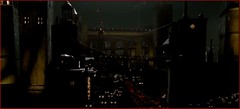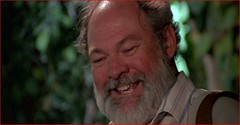
Following up on the post below about 31 Flicks That Give You the Willies, it's once again a great month to find out about underseen and underrated horror movies. I recently took in two of these flicks, and have nothing but good to say about both of them:
The Tomb of Ligeia (1964)
A tip of Vincent Price's top hat to Neil Sarver for this one. After reading Neil's recommendation, I saw that TCM was showing the Roger Corman classic the following day -- huzzah! The Tomb of Ligeia contains one of my new favorite openings of any horror movie. How could you turn away after hearing these opening lines:
"You cannot bury her in consecrated ground, she was un-Christian!"The opening scene is a dark funeral procession at a crumbling English abby. Price's character, Verden, carries the body of his wife Ligeia, which has a convenient window to display her face. After she is lowered into the ground, we see her eyes pop open, which Verden attributes to a "simple reflex." A snarling black cat walks over her grave, and the pallbearers leave in horror, Verden asking if "cat got your tongue?" The film's title is displayed over the cat and Ligeia's tombstone, then we're taken through a creative credits scene of numerous gothic paintings featuring the abby and that darned cat.
"This is my ground."
"It's the Lord's ground."
"Then let the Lord refuse her."
"She will not rest with the Christian dead."
"She will not rest for she is not dead ... to me. And she will not die for she willed not to die."
It's a beautiful beginning to an entertaining movie, shot in gorgeous widescreen in England and on a familiar Corman set that was also used for The Terror, The Raven and The Haunted Palace. The last of Corman's Edgar Allen Poe-based movies, the short story Ligeia provided the basis here. Poe's 1838 story featured a narrator married to the strange title character, although he could not remember her last name or quite how they met. His wife was obsessed with the philosophy of a person's will to live, and also die, and continues through her passing. As in most Poe stories, the ending packs a punch. Corman's movie does not show us any of Ligiea's life, instead focusing on Verden and his relationship with Lady Rowena, whom he meets shortly after the opening funeral.
 A dapper gentleman who is forced to wear bad-ass wraparound sunglasses due to light sensitivity, Verden is haunted by Ligiea's existence, or lack thereof. Strange things happen after her death: the date of her death is removed from her tomb (Verden probably did it, but he can't remember), a hunting party's trophy fox disappears from plain view (a fox was Ligiea's symbol) and that black cat is not exactly welcoming of Rowena. While not scary, The Tomb of Ligeia has an intoxicating atmosphere of morbid English mystery. Verden's abby is an amazing setpiece (particularly in outdoor scenes), and the story builds right up until the pure Poe ending (with a little more action added in from Corman). And as good as the opening dialog was, nothing matches this beauty from Verden, which I hope was taken straight from the Poe text:
A dapper gentleman who is forced to wear bad-ass wraparound sunglasses due to light sensitivity, Verden is haunted by Ligiea's existence, or lack thereof. Strange things happen after her death: the date of her death is removed from her tomb (Verden probably did it, but he can't remember), a hunting party's trophy fox disappears from plain view (a fox was Ligiea's symbol) and that black cat is not exactly welcoming of Rowena. While not scary, The Tomb of Ligeia has an intoxicating atmosphere of morbid English mystery. Verden's abby is an amazing setpiece (particularly in outdoor scenes), and the story builds right up until the pure Poe ending (with a little more action added in from Corman). And as good as the opening dialog was, nothing matches this beauty from Verden, which I hope was taken straight from the Poe text:"Christopher, not ten minutes ago I... I tried to kill a stray cat with a cabbage, and all but made love to the Lady Rowena. I succeeded in squashing the cabbage and badly frightening the lady. If only I could lay open my own brain as easily as I did that vegetable, what rot would be freed from its grey leaves?"I Walked With a Zombie (1943)

These Val Lewton/Jaques Tourneur movies never cease to entertain, and while it's not as good a movie as Cat People, it's equally as bold and mysterious. One of the most interesting elements of this movie is the title, which seems to put it in the same league as Teenagers from Outer Space or My Stepmom's a Werewolf. I took the "walk" in the title as a courtship slang, maybe equating to I Went With a Zombie, and expected a tale of a husband or boyfriend who turned into a zombie. And when you learn that the title is literal, the choice seems strange or perhaps a bad translation ("You walked with a zombie? Big whoop, my family got eaten by them!").

While the title is a little off, the film is anything but. A reworking of Jane Eyre, I Walked With a Zombie shares the novel's concept of a husband with a wife allegedly gone mad, with a comely new woman firmly in his sights. Betsy is a nurse who has agreed to help on a Caribbean plantation, where she cares for the owner's wife Jessica. Suffering from the strange effects of a local fever, Jessica is in a near vegetable state -- a zombie. Constantly dressed in flowing white with an eerily distant stare, Jessica is the haunting mystery that is central to the film. After falling in love with husband Paul, Betsy is determined to cure Jessica, as her condition seems to defy medical logic.
The film's title refers to its most satisfying scene, when Jessica and Betsy walk through the plantation's wheat fields to a spooky voodoo gathering. With this scene, the relationship between Betsy and Jessica gathers some sapphic qualities, especially if you interpret the "walk" element the way I did. It's a beautiful scene, with the moonlight shining through Jessica's gown and the scenery allowing you to almost feel the West Indies night heat. Tourneur has a field day with the odd voodoo elements, and Darby Jones' piercing Carrefour character is the physical embodiment of the area's zombie practices, with bulging eyes and an emaciated gait. Not one of the scarier of producer Val Lewton's horror movies, but the sexual undercurrent in a creepy voodoo land appeal of I Walked With a Zombie makes it memorable.












1 comment:
Two movies off my list! How excellent! I'm glad you enjoyed them both.
Post a Comment